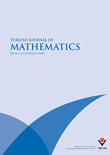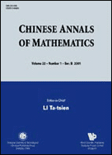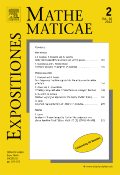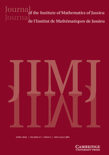
Archivum Mathematicum
Scope & Guideline
Fostering Collaboration in Mathematical Research
Introduction
Aims and Scopes
- Geometric Analysis and Differential Geometry:
The journal frequently publishes research on manifold theory, curvature, and geometric structures, highlighting applications in both finite and infinite dimensions. - Functional and Fractional Differential Equations:
A significant portion of the articles focuses on the analysis of differential equations, especially those of fractional and functional types, including their solutions and stability properties. - Algebra and Algebraic Structures:
Research pertaining to algebraic structures, such as lattices, rings, and superalgebras, is a core aspect of the journal, emphasizing both theoretical developments and applications. - Mathematical Modeling and Applied Analysis:
The journal features studies that model real-world phenomena using mathematical techniques, particularly in areas like chemotaxis, fluid dynamics, and reaction-diffusion systems. - Topology and Homotopy Theory:
Explorations of topological spaces, homotopy equivalences, and related concepts are prevalent, contributing to the understanding of complex mathematical structures. - Numerical Methods and Computational Mathematics:
The journal includes works on numerical analysis, particularly those that address the computational aspects of mathematical problems in various fields.
Trending and Emerging
- Advanced Differential Equations and Their Applications:
There is a notable increase in research focused on complex differential equations, particularly those involving advanced techniques such as fractional derivatives and nonlocal conditions, reflecting the growing interest in dynamic systems. - Mathematical Physics and Geometry:
Emerging themes include the intersection of mathematics with physics, particularly in areas like noncommutative geometry and mathematical structures in theoretical physics, indicating a trend towards interdisciplinary research. - Computational Mathematics and Algorithm Development:
A rising focus on computational techniques and numerical methods for solving mathematical problems suggests an increased interest in practical applications and simulations in various mathematical fields. - Homotopy Theory and Algebraic Topology:
Research in homotopy theory and algebraic topology is becoming more prominent, showcasing a growing interest in understanding the foundational aspects of topology in a more abstract and algebraic context.
Declining or Waning
- Classical Analysis Techniques:
There appears to be a reduced emphasis on traditional techniques in classical analysis, such as basic convergence theorems and elementary function properties, as more complex and applied topics gain traction. - Elementary Number Theory:
Research articles focusing on elementary aspects of number theory, including simple Diophantine equations, have become less frequent, possibly overshadowed by more advanced algebraic and geometric studies. - Basic Combinatorial Geometry:
The journal has seen fewer contributions on combinatorial aspects of geometry, suggesting a potential shift towards more algebraic or topological approaches in geometric research.
Similar Journals

Revista Matematica Complutense
Elevating Academic Dialogue in MathematicsRevista Matematica Complutense is a prestigious peer-reviewed journal published by SPRINGER-VERLAG ITALIA SRL, specializing in the field of mathematics. With its ISSN 1139-1138 and E-ISSN 1988-2807, the journal plays a vital role in disseminating high-quality research and fostering academic discussion within the mathematics community. Recognized for its rigorous selection process, the journal has achieved impressive rankings, holding a Q1 quartile status in the miscellaneous mathematics category as of 2023 and ranking #94 out of 399 in general mathematics according to Scopus, placing it within the 76th percentile. With a publication timeline spanning from 2008 to 2024, the Revista Matematica Complutense continues to serve as an essential resource for researchers, professionals, and students alike. Although it does not currently offer open access, the journal remains committed to advancing mathematical knowledge and providing a platform for innovative research across various mathematical disciplines.

ANNALI DI MATEMATICA PURA ED APPLICATA
Advancing Knowledge Through Rigorous ResearchANNALI DI MATEMATICA PURA ED APPLICATA is a prestigious journal published by Springer Heidelberg, focusing on the field of Applied Mathematics. With a rich history dating back to its initial publication stages from 1858, this journal continues to serve as a vital platform for researchers and professionals seeking to disseminate high-quality, peer-reviewed research. The journal's strong reputation is reflected in its Q1 ranking in Applied Mathematics and its Scopus rank of #335 out of 635, placing it in the 47th percentile, showcasing its impact in the field. Although it is not an open-access journal, it provides exclusive insights and advancements in mathematical applications, allowing academics to explore innovative methodologies and theoretical developments. The combination of its long-standing tradition and contemporary relevance makes ANNALI DI MATEMATICA PURA ED APPLICATA an essential resource for scholars and students looking to deepen their understanding of mathematics and its practical applications.

Facta Universitatis-Series Mathematics and Informatics
Advancing Knowledge: Your Gateway to Mathematical and Informatic InsightsFacta Universitatis-Series Mathematics and Informatics is a prestigious interdisciplinary journal published by UNIV NIS that emphasizes the integration of mathematical theories and computational methods essential for advancements in various scientific fields. With the ISSN 0352-9665 and E-ISSN 2406-047X, this journal serves as a vital platform for researchers and professionals to disseminate cutting-edge findings related to mathematics and informatics. As an open-access journal, it aims to enhance the visibility and accessibility of high-quality research, fostering collaboration among scholars globally. The journal's commitment to excellence is evident in its rigorous peer-review process, which ensures that only the most impactful and innovative research papers are published. Set against the backdrop of its esteemed Serbian institution, Facta Universitatis not only aims to contribute to the global academic discourse but also to inspire the next generation of mathematicians and computer scientists. As the field continues to evolve, this journal plays a crucial role in shaping the future landscape of mathematics and informatics.

Turkish Journal of Mathematics
Pioneering Insights in the World of MathematicsTurkish Journal of Mathematics is a prestigious academic publication dedicated to the advancement of mathematical research across a variety of subfields. Established in 1995 and published by the Tubitak Scientific & Technological Research Council Turkey, this journal has built a solid reputation, especially noted for its significant contributions to the field over the years, with its convergence spanning from 1995 to 2002 and again from 2006 to 2024. The journal, which holds a commendable Q2 ranking in Mathematics (miscellaneous) and is positioned in the 66th percentile of Scopus rankings for General Mathematics, aims to disseminate high-quality original research, reviews, and innovative methodologies to advance both theoretical and applied mathematics. Researchers, professionals, and students alike will find invaluable resources within its pages, providing insights that are pivotal for academic and practical applications in mathematics. Although it does not currently offer open access options, the journal remains an essential platform for those looking to engage with the forefront of mathematical inquiry.

Rendiconti del Circolo Matematico di Palermo
Cultivating Mathematical Excellence Since 1887.Rendiconti del Circolo Matematico di Palermo, published by SPRINGER-VERLAG ITALIA SRL, is a revered journal in the field of mathematics, emphasizing the cultivation and dissemination of mathematical knowledge since its inception in 1887. With its ISSN 0009-725X and E-ISSN 1973-4409, this esteemed publication has continued to thrive, showcasing innovative research, comprehensive reviews, and thoughtful discussions from diverse areas in mathematics, particularly in its Q2 ranking within the miscellaneous mathematics category. Its historical significance is underscored by its convergence of publications across numerous years, including its notable periods from 1887 to 1916, 1919 to 1938, and beyond, effectively capturing the evolution of mathematical thought. Though not open access, the journal remains an essential resource for researchers, professionals, and students aiming to stay updated with the latest advancements and methodologies in the ever-evolving landscape of mathematics. With its Scopus rank placing it in the top 25th percentile, Rendiconti del Circolo Matematico di Palermo continues to be a cornerstone for scholarly dialogue and development in its domain.

Analele Stiintifice ale Universitatii Ovidius Constanta-Seria Matematica
Elevating the Discipline of Mathematics with Scholarly ExcellenceAnalele Stiintifice ale Universitatii Ovidius Constanta-Seria Matematica is a prominent open-access journal established by OVIDIUS UNIV PRESS in Romania, dedicated to advancing the fields of mathematics, specifically in Analysis and Applied Mathematics. Since its inception, the journal has emphasized the dissemination of high-quality research, making it accessible to a global audience. With an ISSN of 1224-1784 and E-ISSN 1844-0835, it has positioned itself within the academic community, achieving a respectable Q3 ranking in both analysis and applied mathematics in 2023, reflecting its commitment to rigorous scholarship. The journal spans a considerable publication window from 2009 to 2024, catering to the ongoing developments in mathematical sciences and their applications. Researchers, professionals, and students alike will find valuable insights and contributions that enrich their understanding and foster collaboration within the mathematical community. The journal's headquarters is based at the Faculty of Mathematics & Computer Science, Bulevardul Mamaia 124, Constanta, Romania.

CHINESE ANNALS OF MATHEMATICS SERIES B
Advancing Mathematical Frontiers with Regional InsightsCHINESE ANNALS OF MATHEMATICS SERIES B, published by Shanghai Scientific Technology Literature Publishing House, is a prominent journal dedicated to fostering research and development in the field of mathematics. With an ISSN of 0252-9599 and an E-ISSN of 1860-6261, this journal provides a platform for the dissemination of innovative mathematical theories and methodologies. As of 2023, it is categorized within the Q4 quartile in *Applied Mathematics* and has achieved a commendable Q3 rank in *Mathematics (miscellaneous)*, emphasizing its growing influence in academia. Despite not being an open-access publication, it serves as a valuable resource for researchers, professionals, and students seeking to explore diverse mathematical topics, particularly from a unique regional perspective. The journal's extensive publication history—from 1980 and continuing to 2024—demonstrates a longstanding commitment to advancing mathematical knowledge and providing insights into various disciplines related to mathematics.

EXPOSITIONES MATHEMATICAE
Cultivating Knowledge in the Heart of Mathematical InquiryEXPOSITIONES MATHEMATICAE, published by Elsevier GmbH, stands as a significant journal in the realm of mathematics, catering primarily to researchers, professionals, and students. With an ISSN of 0723-0869 and an E-ISSN of 1878-0792, this journal has made its mark in the academic community, boasting a Q2 classification in the miscellaneous mathematics category for 2023, illustrating its prominence within its field. The journal addresses a diverse scope of mathematical topics, encouraging the publication of original research and innovative theories while maintaining rigorous academic standards. As it converges from 2004 to 2024, EXPOSITIONES MATHEMATICAE continues to be an essential resource for advancing mathematical knowledge and fostering scholarly communication, despite being a non-open-access publication. Its location in Munich, Germany further anchors it within a rich intellectual tradition, providing accessibility for the mathematical community worldwide.

Advanced Studies-Euro-Tbilisi Mathematical Journal
Exploring New Frontiers in MathematicsAdvanced Studies-Euro-Tbilisi Mathematical Journal, published by the esteemed TBILISI CENTRE MATH SCI, is a vital resource for scholars and practitioners in the field of mathematics. Since its inception in 2021, this journal has committed to advancing knowledge across various mathematical disciplines, including Algebra and Number Theory, Analysis, Applied Mathematics, and Geometry and Topology, although it currently holds a category quartile ranking of Q4 in all these areas. With an open-access format, it provides unparalleled access to cutting-edge research to a global audience of researchers, professionals, and students, fostering collaboration and innovation within the mathematical community. Operating from TBILISI, Georgia, the journal acknowledges the growing importance of diverse geographical contributions to mathematics and aims to spotlight emerging research trends. As research continues to evolve, Advanced Studies-Euro-Tbilisi Mathematical Journal seeks to enrich the academic dialogue and support the dissemination of mathematical knowledge.

Journal of the Institute of Mathematics of Jussieu
Shaping the Future of Mathematics, One Article at a TimeJournal of the Institute of Mathematics of Jussieu, published by Cambridge University Press, is a leading academic journal that has established itself as a vital resource in the field of mathematics. With an impressive impact factor and a ranking in the top quartile (Q1) of miscellaneous mathematics, the journal serves as a platform for high-quality research from both established scholars and emerging researchers. Spanning from 2002 to 2024, the journal aims to foster collaboration and innovation in the mathematical community by publishing original research articles, reviews, and critical discussions on a wide range of mathematical topics. Although the journal does not offer open access, it remains widely accessible through various academic institutions and libraries, ensuring that critical advancements in mathematics are shared with a global audience. Located in the United Kingdom at the prestigious Cambridge campus, the journal reflects the rigorous standards of its publisher and the rich academic tradition of its home institution.